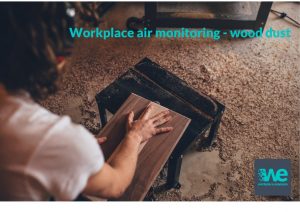Workplace Air Monitoring
Following the workplace air monitoring for wood dust, all our results were well below the Workplace Exposure Limit (WEL). Is that it or do we still have to do something?
It’s a question we often get asked, your dust measurement survey is one of the first stages to assessing your workplace dust issues as required by the COSHH Regulations. This determines where you need to focus your efforts in controlling dust exposure to your workers.
Wood dust can come from hardwood, softwood, plywood, MDF, chipboard and laminated wood products. Whilst it is encouraging to see results below the WEL, a survey is only a snapshot of just one day. There can be many variations in exposure, from day to day and between workers.
These can be due to many factors, for example, variations arise from how often machines are used to cut wood, whether the dust extraction is switched on or not, how much cleaning up is carried out and by which method. Sweeping up dust puts more dust into the air rather than removing it by means of a suitable industrial vacuum. Some workers may sweep their bench and brush dust towards them or onto the floor instead of away and into the bin.
Workplace Exposure Limit (WEL)
The Workplace Exposure Limit (WEL) for wood dust is 5mg/m³, as an 8hr time weighted average (8hr TWA) so the workplace air monitoring results will be compared with this limit as part of the conclusions in the report.
As wood dust is an asthmagen, even small quantities can cause respiratory sensitisation. Hard woods, for example, Oak, Iroko, and Western Red Cedar, are carcinogens so can give rise to more serious health effects such as nasal cancer.
COSHH Risk Assessment
For any wood dust, due to the health effects, whether hard, soft or composite, the COSHH regulations place an extra need on controlling exposure to a level that is “as low as is reasonably practicable” below the exposure limit, to minimise dust exposure. A COSHH risk assessment still needs to be completed to consider all points of the process where dust is likely to be released and practical control measures put in place to further reduce dust emissions.
A COSHH Risk assessment needs to include other aspects of exposure, such as skin contact, as contact with some woods can cause dermatitis – a skin reaction. Also look at where and how dust exposure occurs, such as cutting and shaping wood at machines, sanding and finishing, assembly, and not forgetting cleaning and emptying dust extraction units.
Assess the Risks
An action plan with the aim of continuous improvement by effective control measures is the goal for best practice. This needs to cover training, workplace air monitoring of personal dust exposure levels to check on controls, PPE suitability and use, health surveillance, reviewing and revising procedures.
It’s not necessarily just about wood dust though, there could be other hazardous substances used within the wood working process. Look at any adhesives, paints, stains or vanishes used, or stripping fluids, lubricants and disinfectants to treat water systems.
Workplace Exposure are here to help, if you need any monitoring, advice or assistance please get in touch.
Our approach
Get in touch with Workplace Exposure, either give us a call on 0800 689 4386, or fill in our enquiry form to discuss your monitoring or consultancy requirements.
We’ll then provide you with a no obligation proposal, we can often give an initial idea of fees whilst we discuss your needs.
Once you’ve accepted our proposal we can then schedule the work.
Following our site visit we’ll provide you with a comprehensive report giving you advice, recommendations and control measures where appropriate.
Implement the outcomes for compliance and a happier healthier workplace.
Further information
For further information and reading the Health & Safety Executive (HSE) has woodworking web pages here.

